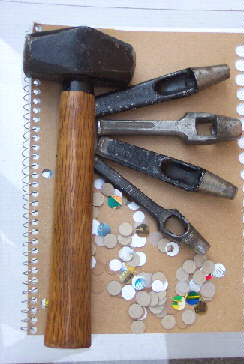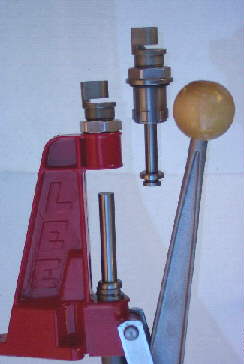| Gunpowder by Rowdy Yates
Many Cowboy Shooters are drawn by the mystique of shooting
Black Powder or one of it’s many substitutes but there is such a variety
of Powders to choose from that it is difficult to make a decision of which
one to use and how to get started.
Hopefully we can make that decision a bit easier with
some background and pertinent information.
In this neck of the woods there are several types of powders
that are available.
The regular black powder would include Goex, Swiss and
Shutzen. For Cowboy shooting any one of these will get you started in the
game.
Goex has recently provided a new powder called “Cowboy”
and so far I am very impressed with it. This powder is recommended for
cartridges and front stuffers in amounts less than 40 grains and for shooting
the stages in a CAS match this powder provides a clean burn and good power
in both the pistol caliber cartridges and in the shotgun. Of course more
powder is used in the shotgun but I’m very satisfied with the results.
My choice for cap and ball is usually fffg Goex but I’m switching to Cowboy.
The use of any of the regular Black Powders will require
a soft lube such as Lyman Black Powder Gold, SPG, or Javalina. There are
also many home recipes that may be the fodder for an article for another
day.
In general the more lube the better so you will need a
bullet design that carries as much as possible.
Hodgden has recently provided a powder called “Triple
7” which has good performance and does not require the use of special lubricants.
This powder was developed primarily for the front stuffers used in hunting
but in the smaller cowboy calibers (38, 357 etc.) works very well. For
the larger CAS calibers (.45 Colt, 44WCF etc.) make sure you go with the
ffg granulation.
Another BP substitute is American Pioneer Powder. This
powder gives adequate performance and also provides a unique benefit in
that no lube of any kind is needed in either cartridges or Cap And Ball
use.
APP works well in all aspects of CAS including the larger
capacity cartridges of the Plainsman event. (38-55, 45-70 etc.) This powder
is probably the least hassle of all and is likely the powder of choice
for those looking to put out as little effort as possible and still participating
in the Black Powder categories and events.
While this literary tid bit doesn’t even scratch the surface
it should be enough to get you started into what some have termed the dark
arts.
Rowdy Yates |

Wads by Old Scout
Wads; card, plastic, grease, wax, felt, cork, etc.
The most important single facet of the lead
bullet, when searching for accuracy , is the base. The slightest imperfection
of the bullet base will have a very pronounced effect on just where that
bullet goes on it's trip down range!
The lead bullet, in plain base form, is soft and easily
damaged. Upon firing, the very high breach pressure will drive unburned
powder grains into the bullet base, distorting its shape. Combustion gases
may also leak past the base of the bullet causing some melting or “gas
cutting” of the bullet. The latter condition is common to production rifles
with poorly designed throats, and may lead to poor accuracy as well as
leading.
Throughout the history of the black powder
cartridge rifle it has been common practice to place a disk of some material
between the powder charge and the bullet base. In days of old, disks of
cardboard, felt and cork , called wads were often used. The term “Wad”
may stem from the days of the muzzle loading shotgun, where wads of any
handy material were placed between the powder and shot.
In any event, the use of a wad under the
bullet serves to protect the bullet base, and sense most materials will
expand some due to breach pressure, helping to seal the throat
reducing gas cutting. The wad, which should be a tight fit in the cartridge
case, will also help prevent migration of the bullet lube into the powder
charge.
Black Powder shooters tend to be “do it yourself”
folks, and many of us make our own wads. Figure 1 shows the method used
most often. The good ole hole Punch & hammer method. Keep the punch
sharp by stoning the edge, drive it against a block of wood, and a good
supply of wads can be produced with moderate effort. For those that would
prefer a more modern approach, figure 2 shows a wad punch that is mount
on a reloading press. This device will effortlessly produce wads from most
any material you feed it!
For bullet base protection the wads may be
of most any heavy card material. The most commonly used is tablet backing.
Some shooters use milk carton. I find this a little thinner than I like,
but many shooters use it to good advantage. I like to see wad material
range from .025” to .060” thickness. The plastic covers that come on Coffee
cans also see some use as wad material. This plastic is called LDPE ( low
density poly-ethylene) and is softer than card stock. The LDPE wads expand
more during firing than do the card wads, and may be of value in loose
throated rifles.
So far we have talked only of protecting
the bullet base, but wads have other uses. One such use is to provide additional
lubrication and/or cleaning action. Lube wads take the form of felt soaked
in bullet lube, or actual sheets of bullet lube. For many years I purchased
old felt hats from Thrift Stores, soaked them in melted lube, and made
wads of them. Another approach used by some is to form actual bullet lube
into sheets and cut wads of that. I obtain a soft wax ( called Dental Wax
) in 1/16” thick sheets, which I use to good advantage in some arms.

Figure 1 |

Figure 2 |
When working with the soft wax, or grease wads,
and also the greased felt wads, it is necessary to place a good tight card
wad on the powder, then the “greasy stuff” and then a thin card wad over
the gooey stuff. That last wad is there to prevent the grease wad from
sticking to the bullet base. Everything must separate from the bullet at
the muzzle. Any wad that sticks to the bullet, even for a few feet, will
cause a flier. In the case of the true grease wad, the top card is not
necessary. The grease should be squeezed out onto the bore, with nothing
left at the muzzle.
I know of shooters who purchase a deck of
playing cards and turn it all into wads. Then place one on either side
of their lube wads. I found a supply of hard card material that is .009”
thick, and makes excellent wads for use with my wax or greased felt wads
( one on either side ). For my “standard” wad I use a material that looks
like tablet backing but is .045” thick. This is the separator used in wine
cases. Being a Wino by nature, I have a good supply of this material!
I will take up primer wads and shotgun wads
another time.
Cheers,
Old Scout
|